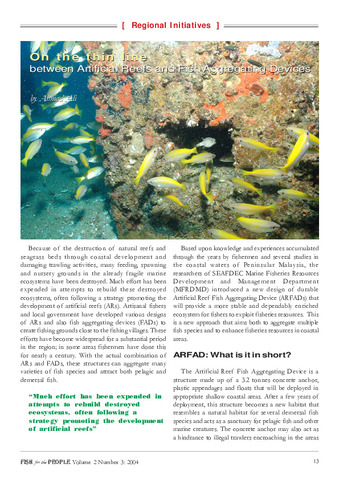បង្ហាញកំណត់ត្រាសាមញ្ញសម្រាប់ធាតុ
On the thin line between artificial reefs and fish aggregating devices
Share
| dc.contributor.author | Ali, Ahmad | |
| dc.date.accessioned | 2017-09-19T02:08:16Z | |
| dc.date.available | 2017-09-19T02:08:16Z | |
| dc.date.issued | 2004 | |
| dc.identifier.issn | 1685-6546 | |
| dc.identifier.uri | http://hdl.handle.net/20.500.12066/692 | |
| dc.description.abstract | Details are given of a new design of durable Artificial Reef Fish Aggregating Device (ARFAD) developed by researchers of SEAFDEC Marine Fisheries Resources Development and Management Department. This new approach aims to both aggregate multiple fish species and also enhance fisheries resources in coastal areas. An ARFAD has 3 components: floats, an attractor and an anchored mooring. The development of durable ARFADs is expensive as the anchor, line and aggregating devices must be able to resist the forces of wind, waves, currents and the corrosive action of seawater. In addition to being effective for artisanal application in which fishing effort is relatively low, well placed ARFADs deployed at suitable sites will in the long term become alike to an artificial reef, enhancing coastal habitats and resources for the benefit of the nearby communities and ecotourism. | en |
| dc.language.iso | en | en |
| dc.publisher | Secretariat, Southeast Asian Fisheries Development Center | en |
| dc.subject | South East Asia | en |
| dc.title | On the thin line between artificial reefs and fish aggregating devices | en |
| dc.type | magazineArticle | en |
| dc.citation.volume | 2 | |
| dc.citation.issue | 3 | |
| dc.citation.spage | 13 | |
| dc.citation.epage | 18 | |
| dc.citation.journalTitle | Fish for the People | en |
| dc.subject.asfa | marine fisheries | en |
| dc.subject.asfa | attracting techniques | en |
| dc.subject.asfa | Catching methods | en |
| dc.subject.asfa | artisanal fishing | en |
| dc.subject.asfa | artificial reefs | en |

